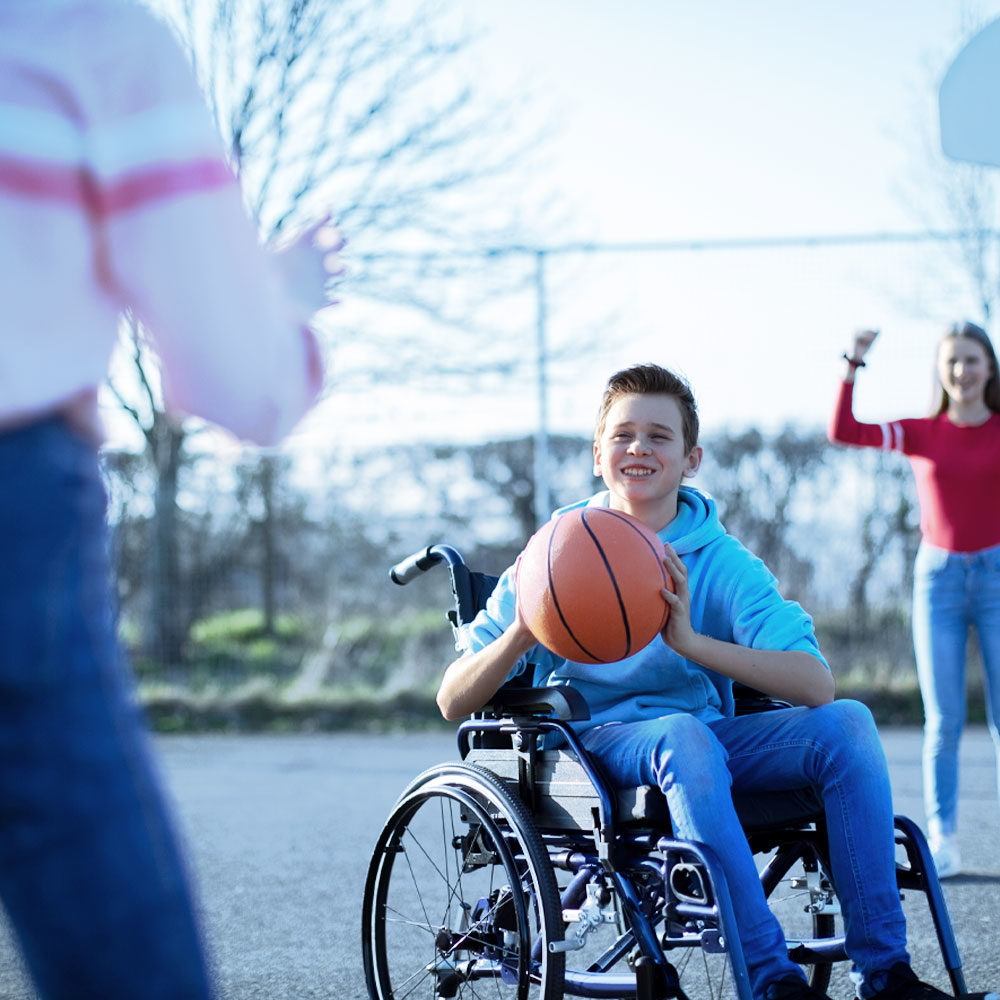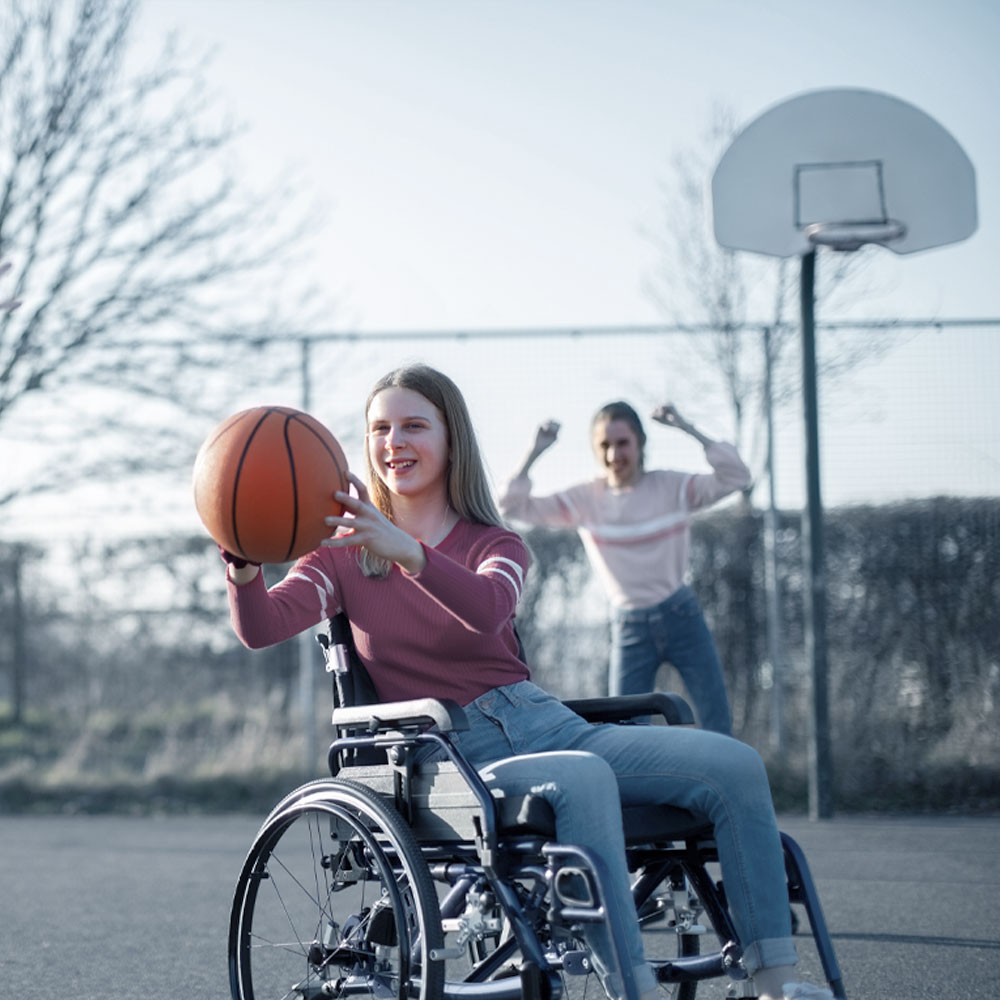
Physical Capabilities refer to the degree to which a person can manage the physical tasks of daily living.
These capabilities can be compromised by three categories of physical disabilities commonly found in children (1) physical disabilities that result from the spinal cord and column (e.g. traumatic spinal cord injuries, spina bifida), (2) physical disabilities that are caused to various parts of the brain (e.g. cerebral palsy and traumatic brain injury), and (3) physical disabilities like limb deficiency, including amputations (Block, 2016A teacher’s guide to adapted physical education: Including students with disabilities in sports and recreation. Baltimore: Brookes. This book is helpful in providing guidance on inclusive PE lessons. Chapters on Curricular and Game and Sport modifications are particularly useful in presenting adaptations for children with a physical disability. Regular references to research strengthen the theoretical basis for inclusion and strategies to promote inclusion. Particular sections focus on promoting understanding of the causes, incidence, treatment, health and medical issues that impact on children’s inclusion.).
It is important to recognise the characteristics of children with physical impairments that effect movement or functional ability. However, by listening to the voice of the child and to others such as therapists who work with the child, we can ensure that the capabilities of the child rather than the disability is the focus. The overall aim is to ensure that the child reaches their physical and functional skill development potential.
(WU) symbolises adaptations that can help a child who uses a wheelchair.
- Widen target initially to allow for restriction of chair when throwing at a target. (WUWheelchair user)
- Ensure that equipment to be collected is on top of e.g. high stool, upturned bucket or provide a litter picker on the raised surface to enable the child to pick some objects from the floor e.g. beanbag, foam javelin. (WU)
- Skipping: place ropes on the floor making different shapes so that the child can steer a wheelchair along/across/beside. (WU)
- Mirror on wall to increase body awareness
- Pool temperature needs to be suitable for child who may be unable to keep warm easily if mobility is seriously restricted. (WU)
- Ball on string to aid swift retrieval. (WU)
- Short handled bat/short lever. (WU)
- Longer floor hockey/unihoc stick to help reach the floor from chair. (WU)
- Balls tied to a wheelchair are easy to retrieve. (WU)
- Using a rebounder/net aids retrieval. (WU)
- Child crawls/manoeuvres under a rope placed off the ground (skipping). (WU)
- Prompt children to move along on lines or down lanes (from straight to curved to zigzag). (WU)
- When dribbling a ball, the child can use either a foot or crutch as needed. Footrests on chairs can be used to propel the ball. (WU)
- Gross motor skills may need to be practised in the sitting or lying position. (WU)
- Children are allowed to dribble and push the wheelchair only twice before passing or shooting in a game of basketball; they are not allowed to rebound inside the lane lines (allowing other children to jump without fearing tripping on a chair on landing). (WU)
- All children take walking paths in scavenger hunt/orienteering activities to ensure that it is accessible for wheelchair user. (WU)
- Adapt distance: allow child to select a closer target for shooting practices.
- Use swim aids indefinitely to promote independence.
- Swim fins can help children remain horizontal to the direction of travel and increase speed.
- TheraBand’s can be useful to aid strengthening.
- Lower steps e.g. thin plank rather than bench for stepping onto.
- Child steps over a rope placed on the ground, then jumps with two feet over rope on the ground when skipping (no arm movement necessary).
(WU) symbolises adaptations that can help a child who uses a wheelchair.
- Identify the characteristics of children with physical impairments that effect movement or functional ability.
- Show video clips of disability sport where for example children can see athletes with prostheses or using wheelchairs. Discuss these clips with the whole class.
- Prompt and guide children through a task where ‘rebuilding motor skills’ is necessary.
- Ensure that you include lots of upper body mobility work e.g. using hands to throw/catch/strike using hand or racket as well as dance movements and ‘imaginary’ movements using hands as illustrated in ‘Magic’ playground game in the Inclusive Practices section of this thematic module’. (WUWheelchair user)
- Parachute games are ideal to help integrate a child with peers and to develop upper body posture, functioning and motor skill development. (WU)
- Treat children individually and encourage participation throughout lessons.
- Individualised instruction by the class teacher where needed and where possible.
- When jumping for height or distance motivation is increased when a colourful ribbon marks the target area.
- Use percussion with a slow beat to prompt hopping slowly with balance and using fast tempo to hop repeatedly and rhythmically.
- Encourage the child to use a wall when practising throwing/striking skills to limit the time lost in retrieval.
- Prompt children to push and pull e.g. push against a wall, push against a partner, do a modified push up using own body weight.
- Rules can be adapted e.g. in bowling games, two handed bowl is permitted.
- Adapt tempo of dance activities.
- Child serves in tennis/volleyball from reduced distance or serves with a bounce.
- Allow shooting into an empty goal (with no goalkeeper).
- Allow a child to shoot at a target without pressure from defence.
- Eliminate tag-outs (rounders, softball).
- Child walks sideways with assistance on the bench/beam to aid balance.
- Play disability sport (e.g. sitting volleyball) as a whole class for some of a games unit of work.
- Include stretches in the warm-up that focus on proper alignment and strengthen core muscles.
- Use physio balls (as one ‘station’ in a station teaching context) to improve posture and breathing.
- Tactile modelling where teacher/teaching assistant helps child appropriately with a range of motion.
(WU) symbolises adaptations that can help a child who uses a wheelchair.
- Remember that the disability should not be the focus but rather the capabilities of the child, to ensure that the child reaches his/her physical and functional skill development potential.
- Consider including some cardiovascular (aerobic) activities to control weight and maintain functional ability. Some activities designed to promote upper body flexibility for all children may help a child who is a wheelchair user, for example, to transfer from a wheelchair and to enhance wheelchair manoeuvring.
- Support from an assistant to physically assist especially when moving from wheelchair to crutches or onto mat. (WUWheelchair user)
- From floor pull self into wheelchair. (WU)
- May need therapy and/or assistive devices to position themselves sitting on the floor/mat or standing. (WU)
- Particular attention should be paid to maintaining a full range of motion in lower limb joints. (WU)
- It is very important that children (e.g. those with spina bifida) are encouraged to walk to stimulate bone growth and circulation.
- Children should be encouraged to move with their crutches. However, in PE classes it will be important to be able to use their hands. In this way they can develop handling skills just like their peers. For some activities using a wheelchair may be best.
- Some children may balance on one arm supporting the weight of their legs and prompting them to move with assistance.
- Reflexes experienced by some children will interfere with their intended movement.
- Toe walking occurs when the calf muscle is shortened hence pulling on the heel. Sustained physical activity will be important.
- Listen to the voice of the child, to parents of the child and to others such as therapists who work with the child.


Child with physical disability: spina bifida
Marc is playing games (‘Magic’ and ‘Trucks and Trailers’) with his classmates. Firstly, they run around the play area changing direction frequently prompted by the teacher. Mark manoeuvres the chair expertly. When the teacher calls out ‘magic’ objects the children have to pause and mime the use of the ‘magic object’. Each ‘object’ can be mimed by Mark using her hands e.g. flying a kite, digging with a shovel, twisting a skipping rope, flying like an aeroplane.
Next the teacher explains that the children will play ‘trucks and trailers’. In pairs all children collect a large ball, beanbag or small ball from buckets placed at four points outside the space. Mark asks if he can collect the ball first to ensure that he can reach the ball at the top of the bucket. Each pair stands one behind the other, so Anna (Mark’s partner) stands behind him. Then they move haphazardly around the space, each pair staying close. The teacher provides a signal (percussion) which means that one child throws the ball or beanbag to his/her partner (a throwing skill) 3 times on hearing the signal. Anna and Mark pause and practise this throwing activity varying the distance of the throw. They then run on with Mark leading.
Child with physical disability: cerebral palsy
Maria is included in all PE lessons and her teacher is mindful of her need at times to rest so that her functional ability on the non-affected side of her body will be more efficient as she is not fatigued. During a gymnastics programme she performs some individual balances unaided, some with minimal support but she benefits from the balance/counterbalance activities that she performs with a partner and delights in achieving these. Locomotor tasks though challenging if on a raised surface (e.g. bench) can be supported by a peer or her Teaching Assistant. Sometimes this can mean just walking beside her to enhance her confidence.
She loves parachute games as well as throwing, catching and striking activities. Sometimes she selects a parachute game that she prefers. Her striking and throwing are undertaken using the functional side of her body. She uses a basket on her knees to collect a large ball although she can catch a small ball with one hand. Sometimes her teacher uses the ‘zonal’ approach (see resource section below) in teaching small-sided games (e.g. basketball or Olympic handball) to ensure that Maria can play more effectively as a member of a team. Her manipulation of a wheelchair allows her to partake in these games activities more effectively.
Running activities are very good for her. However, when participating in relay races which she loves, she runs slowly relative to her peers, restricted by her gait. Her teacher modifies the distance so that she can cope better with the challenge. She can manage to pass and receive a baton using the downsweep technique. Maria chooses if she would like to be the lead or anchor runner for example.
Regular allocation of time for the physical education programme ensures that Maria avoids deterioration in performance. Although her individualised therapy programme supports her well, her motivation to perform tasks is heightened in the physical education class due to the social interaction with her classmates.


Child with physical disability: limb deficiency
Rosie’s class teacher has consulted with Rosie and her parents. She takes part in physical education classes where he observes the intensity of the lesson for Rosie making sure that she is able to have rest periods, particularly where she has requested a ‘break’ from activity. Rosie is beginning to learn to play Aussie Rounders and she bats from a tee like most of her peers. She has asked if she can run to a base that is nearer the batting zone and she has placed a marker to signal this point.
During the introductory part of the lesson the teacher includes simple pelvic exercises and abdominal exercises routinely as part of physical education lessons for the whole class. Sometimes the teacher suggests that during play at ‘stations’ the class could take a physio ball and for example stand up, hug it and release it to be retrieved by a partner. They enjoy this and Rosie benefits from this in particular.
Some time has been spent ensuring that classmates accept Rosie as having different legs (with prostheses) supported by video clips of disability sport where the emphasis is on capabilities within classes such as those focused on personal and social development.
Horvat M., Croce, R., Pesce, C., & Fallaize, A. (2019).
Developmental and adapted physical education (6th ed.). NY: Routledge.
Block, M. (2016).
A teacher’s guide to adapted physical education: Including students with disabilities in sports and recreation (4th ed.). Baltimore: Brookes.
Lieberman, L., & Houston-Wilson, C. (2009).
Strategies for inclusion: A handbook for physical educators. NY: Human Kinetics.
Adapting activities
There are some very good examples of adapting activities here using the TREE principles to include young people with disabilities such as those who are wheelchair users in physical education lessons including some audio-visual episodes
The Inclusion Club.
The Active Alliance Charity
There are some nice video clips embedded in this resource that illustrate capabilities of people with disability. The Active Alliance Charity is working to make active lives possible with a vision that disabled people are active for life. Some inspiring stories could be used as a resource by teachers to illustrate capabilities of people with physical challenges.
Inclusive Class Design
The following video provides some ideas on how using zones in games might promote inclusion of a child who is a wheelchair user in a PE lesson.
Disability Sport Awareness
This video has a clear focus on capability.
Irish Wheelchair Association
This resource (Irish Wheelchair Association: Best Start Inclusive Schools Project) illustrates a series of task cards with a range of activities from games to orienteering and provides suggestions on adapting these for children with physical disabilities. It provides guidance on adapting many sports skills and applying skills to game play and sport for children in primary schools who are using a wheelchair.
Niland, E., Barry, M., Dempsey, O., Daly, J. (2010)
Inclusive Schools Project. Dublin: IWA-Sport/Irish Sports Council.
Wheelchair orienteering in Czech Republic
Here is a link to a clip of an adult who is a wheelchair user completing an orienteering course. Note the various ways s/he can be supported. This could provide a teacher with some guidance on how a child might be supported to undertake an orienteering task or indeed how a child might independently undertake the task. Language is Czech, it is very easy to get key messages by just watching.
British Orienteering
Some guidance is available here on how to help an adult who has physical challenges, perhaps using a wheelchair to negotiate an orienteering course. Think about how much of this would be useful to support a child undertaking orienteering during a physical education lesson?
Playworks
There is a small number of useful ideas here to help adapt games for children who are using a wheelchair.
Playworks. Adapted games for students in wheelchairs.
Gymnastics Ireland
These gymnastics resources although designed for use in a gymnastics club setting provide a good picture of capabilities of children with physical challenge.
Professional Development Service for Teachers
There is a small number of suggestions here to help adapt some athletic activities for a child with a physical challenge.
Download PDFIncluding a child who is a wheelchair user in athletic lessons
Inclusion in Physical Education: A Primary Teacher's Actions.
Video LinkThe following conditions can typically be identified as relating to this additional need. It is important, however, that the focus should be on the needs of the individual and adapting the PE environment to create a purposive and inclusive learning environment for all children that values diversity.
- Horvat M., Croce, R., Pesce, C., & Fallaize, A. (2019). Developmental and adapted physical education (6th ed.). NY: Routledge.
This book is helpful in defining particular developmental stages of children and in outlining key teaching strategies when teaching children with congenital and acquired impairments. Use of exemplars provide helpful scenarios where the focus is on the capacity of the child.
- Block, M. (2016). A teacher’s guide to adapted physical education: Including students with disabilities in sports and recreation. Baltimore: Brookes.
This book is helpful in providing guidance on inclusive PE lessons. Chapters on Curricular and Game and Sport modifications are particularly useful in presenting adaptations for children with a physical disability. Regular references to research strengthen the theoretical basis for inclusion and strategies to promote inclusion. Particular sections focus on promoting understanding of the causes, incidence, treatment, health and medical issues that impact on children’s inclusion.











